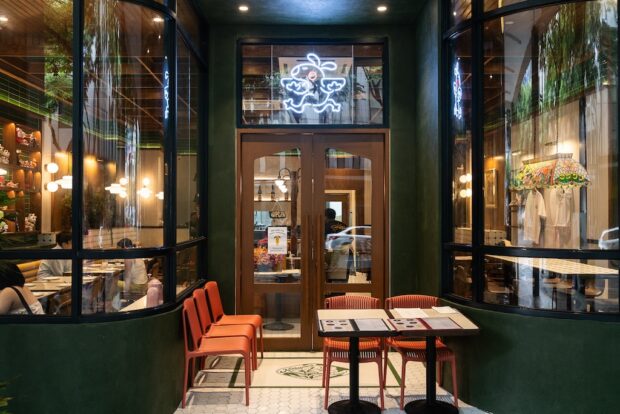Graphic designer and illustrator Raxenne Maniquiz talks about making this IG-trap with Manila’s historied stained glass manufacturer
ICYMI: Salcedo’s favorite hip Japanese restaurant Kodawari is now also in BGC. More than a year after opening its first location, which saw lines and endless selfies at its “Howl’s Moving Castle”-inspired bathroom, the people behind what was once Instagram’s best-kept gyudon has expanded to a second branch in Taguig.
READ: At Kodawari’s IRL gyudon shop, the bowls are king(-sized) and the veg plates divine
Visibly a bigger space than its original post, Kodawari BGC is also visually a league of its own, with every corner a surprise for wandering eyes.

“What we did take from Salcedo was we just also doubled down on the things that made people like the space, which was our approach to art and music,” Kodawari’s creative director Toni Potenciano tells us over a late lunch of their exclusive menu that included seared sea bass in sake butter sauce, a lip-tingling mapo tofu, and cold noodles impeccably dressed with pickled Japanese daikon, sakura floss, tobiko, and zucchini.
Right across the booth we were seated in was a wall shelf brimming with the usual kawaii Japanese pop culture figures. Potenciano says it’s no different from the trinkets present in Salcedo, except this time there’s more intentionality to their display.
Her favorite among the shelf’s residents is Yuna, the evolved version from “Final Fantasy X-2.” “She was like a kept woman in the first one,” she tells me, a non-gamer unfamiliar with Yuna’s lore. “Then in the ‘she-quel,’ she became that,” a sassy, gun-wielding woman in a Y2K-esque getup complete with a belted tiered ombre quarter skirt and knee-high lace-up boots. “So in my opinion, this is, I think, the sexy ‘she-quel’ to Salcedo.”
Another covetable corner and one that will probably have people lining up for this spot is the high tile table up front. The table is lit by a unique lamp designed by graphic designer and illustrator Raxenne Maniquiz. Reminiscent of retro diner-style lamps at retro fast casual restaurants, Kodawari’s version is a trapezoid decorated with a lush and colorful scenery, what Maniquiz considered the visual translation of Kodawari trays.
READ: Filipina artist designs 1,000-piece tropical-inspired puzzle for popular US novelty brand
“The sous vide egg became the setting sun while ‘gyu-dog’ runs across a field of enoki mushrooms and talbos ng kamote. I also added waling-waling (one of my favorites) and sakura flowers to the foliage,” says Maniquiz. “I wanted the color palette to complement the beautiful interiors of the restaurant. That’s where the stained glass swatches came in handy.”
Maniquiz and Potenciano worked with one of the last stained glass manufacturers in Manila, Tiffany Stained Glass and Aluminium Co. Inc., known for their work for religious spaces in the Philippines and abroad. Two of their trained artisans Lauron Prinsipe and Jun Gonzaga were the hands behind Kodawari’s new attraction. Prinsipe has been a fabricator and artisan for many years, previously involved in the craft of mother of pearl and capiz shell ornaments, whose manufacturing is similar to stained glass.
READ: At this design studio, capiz goes out the window and becomes covetable art-like pieces
For this project, Maniquiz started by illustrating the design for the lamp. She then broke each element down into small parts corresponding to a piece of glass that she each assigned a color based on Tiffany’s inventory. The artist recalls that some colors are trickier to pick owing to their different streaks and marbling, but she and Potenciano were determined to highlight those unique features.
“My work has always been highly detailed (and digital) so breaking it down into pieces and simplifying it was part of the challenge. I managed to break it down into 729 parts. The craftsmen sliced the bigger pieces into smaller chunks so maybe closer to 800 pieces for the final output,” Maniquiz says.
In a copy of the to-scale model on Manila paper, Prinsipe shows us how each piece is numbered to indicate its color before assembly. There were no mockups of 3D renders, Maniquiz remembers. “The challenging part for me was more on letting go. I’m so used to knowing what the outcome will look like since they’re usually printed on paper or fabric. We just had to trust that everything will work out right.”
Each glass component varies in size and shape but couldn’t be too small, making it difficult for Prinsipe to solder together. Copper foil is applied on the pieces’ sides as an adhesive that will bind them together to form shapes, images, and in the end a lamp. Prinsipe estimates working on this lamp for roughly a week.
“In my years of illustrating for brands, I’ve always loved it when my work is turned into things people can feel and touch,” Maniquiz reflects upon being reunited with the lamp that took her and Potenciano months to bring to life.
“It brought me so much joy seeing my work as a stained glass lamp. The way each piece catches the light is so special. It was really inspiring to be introduced to this craft. It made us think of projects that can keep the tradition alive.”